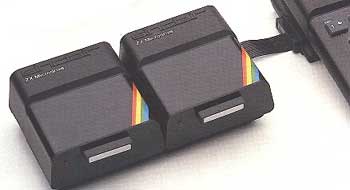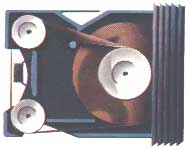|
Microdrive
1983

 |
eBay
online auctions |
| Collectors frequently sell old Sinclair products
on eBay.co.uk.
Click the "GO" button on the left to find any Sinclair
Microdrives being auctioned. |
|
| Best
search term: |
microdrive (sinclair,zx) -book
|
| Availability:
|
Fairly
common, cartridges fairly rare |
| Typical
value: |
Microdrive
- £20-£30
Packet of cartridges - £5
|
| |
More
info on buying & selling Sinclair computers |
The Microdrive was Sinclair's
typically unconventional answer to the Spectrum
owner's desire for a mass storage system. The then-standard
5.25" floppy disk drives were expensive, bulky items
and, as with the ZX
Printer, there was clearly a niche for a budget
alternative. The device was launched in June 1983 for £49.95,
or £79.95 when bought with the Interface
1 (without which the Microdrive could not be used);
both were available in a special "ZX
Spectrum Expansion System" package. Up to
eight Microdrives could be connected side-by-side, daisy-chained
to each other via a slot in the side of the device.
 It
is remarkable that the Microdrive worked in the first place.
It relies on the "stringy floppy" principle - 6m
of 1.9mm tape forms an endless loop inside each tiny cartridge
(right, shown at actual size), running past the Microdive
heads at 76cm per second. Up to 85K of data could be stored
on a cartridge and retrieved at the rate of 15K per second.
As with many other Sinclair products, the tolerances of the
components were pushed to the limits to produce results beyond
what might ordinarily have been expected. It
is remarkable that the Microdrive worked in the first place.
It relies on the "stringy floppy" principle - 6m
of 1.9mm tape forms an endless loop inside each tiny cartridge
(right, shown at actual size), running past the Microdive
heads at 76cm per second. Up to 85K of data could be stored
on a cartridge and retrieved at the rate of 15K per second.
As with many other Sinclair products, the tolerances of the
components were pushed to the limits to produce results beyond
what might ordinarily have been expected.
Unfortunately, again as with
many other Sinclair products, this caused reliability problems.
The cartridges were prone to tangling, had a short service
life and suffered from compatibility problems between different
Microdrives. On top of that, they were also difficult to manufacture
and so were initially scarce and expensive at £4.95
each. Although the price of cartridges eventually fell, the
Microdrive was virtually ignored by software manufacturers
and very few bothered to support it. The public response was
much more positive - the Microdrive sold so well that Sinclair
was forced to limit the number of machines to two per applicant,
which reduced (but did not eliminate) the familiar waiting
lists.
Sinclair also chose the Microdrive
(in a slightly revised version, incompatible with the Spectrum
Microdrive) to be the built-in mass storage device of the
QL.
When the price of conventional disk drives fell in the mid-1980s,
although Amstrad bought the rights to the Microdrive it was
abandoned - instead, Amstrad's own 3" disk format was
used on the Spectrum
+3.

Back
to top
© Chris Owen 1994-2003
|